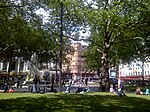Odeon Luxe Leicester Square

The Odeon Luxe Leicester Square is a prominent cinema building in the West End of London. Built in the Art Deco style and completed in 1937, the building has been continually altered in response to developments in cinema technology, and was the first Dolby Cinema in the United Kingdom. The cinema is often used for film premieres. The cinema occupies the centre of the eastern side of Leicester Square in London, featuring a black polished granite facade and 120 feet (37 m) high tower displaying its name. Blue neon outlines the exterior of the building at night. It was built to be the flagship of Oscar Deutsch's Odeon Cinema chain and still holds that position today. It hosts numerous European and world film premieres, including the annual Royal Film Performance.
Excerpt from the Wikipedia article Odeon Luxe Leicester Square (License: CC BY-SA 3.0, Authors, Images).Odeon Luxe Leicester Square
Hunt's Court, City of Westminster Covent Garden
Geographical coordinates (GPS) Address External links Nearby Places Show on map
Geographical coordinates (GPS)
| Latitude | Longitude |
|---|---|
| N 51.51056 ° | E -0.12917 ° |
Address
Odeon Leicester Square
Hunt's Court 24-27
WC2H 7LE City of Westminster, Covent Garden
England, United Kingdom
Open on Google Maps






